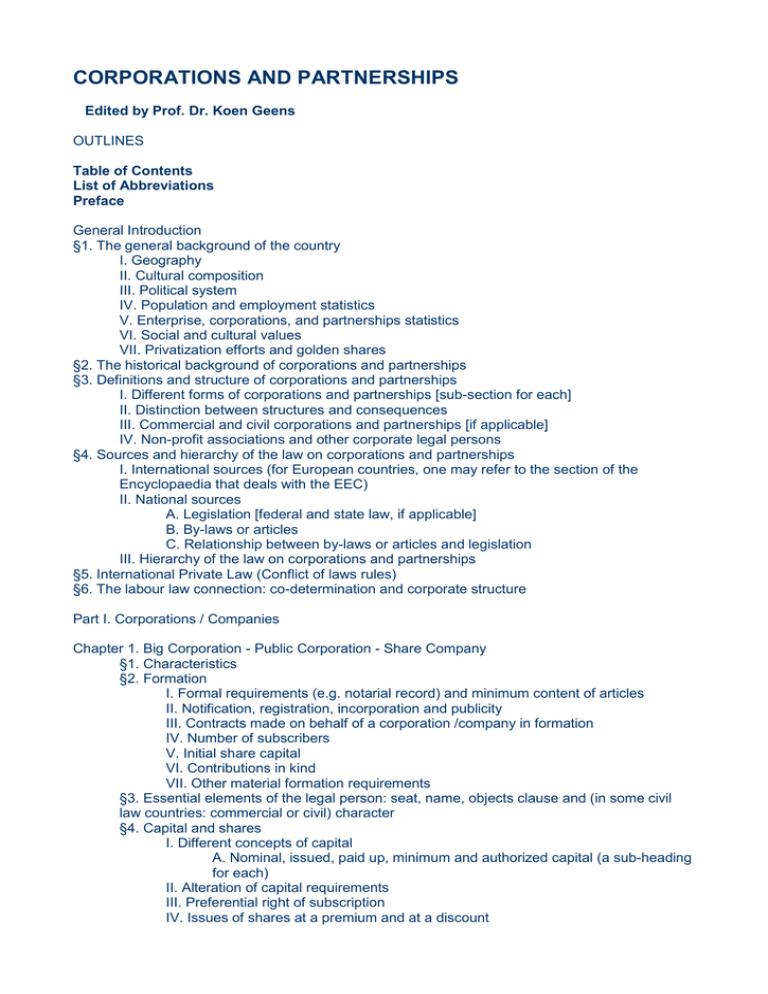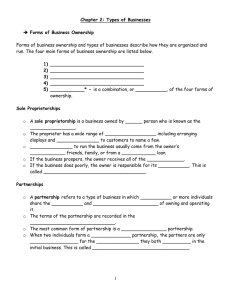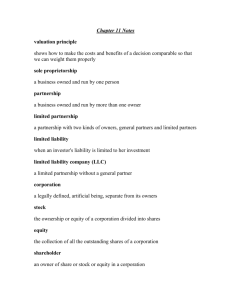Corporations and Partnerships - CER
advertisement

CORPORATIONS AND PARTNERSHIPS Edited by Prof. Dr. Koen Geens OUTLINES Table of Contents List of Abbreviations Preface General Introduction §1. The general background of the country I. Geography II. Cultural composition III. Political system IV. Population and employment statistics V. Enterprise, corporations, and partnerships statistics VI. Social and cultural values VII. Privatization efforts and golden shares §2. The historical background of corporations and partnerships §3. Definitions and structure of corporations and partnerships I. Different forms of corporations and partnerships [sub-section for each] II. Distinction between structures and consequences III. Commercial and civil corporations and partnerships [if applicable] IV. Non-profit associations and other corporate legal persons §4. Sources and hierarchy of the law on corporations and partnerships I. International sources (for European countries, one may refer to the section of the Encyclopaedia that deals with the EEC) II. National sources A. Legislation [federal and state law, if applicable] B. By-laws or articles C. Relationship between by-laws or articles and legislation III. Hierarchy of the law on corporations and partnerships §5. International Private Law (Conflict of laws rules) §6. The labour law connection: co-determination and corporate structure Part I. Corporations / Companies Chapter 1. Big Corporation - Public Corporation - Share Company §1. Characteristics §2. Formation I. Formal requirements (e.g. notarial record) and minimum content of articles II. Notification, registration, incorporation and publicity III. Contracts made on behalf of a corporation /company in formation IV. Number of subscribers V. Initial share capital VI. Contributions in kind VII. Other material formation requirements §3. Essential elements of the legal person: seat, name, objects clause and (in some civil law countries: commercial or civil) character §4. Capital and shares I. Different concepts of capital A. Nominal, issued, paid up, minimum and authorized capital (a sub-heading for each) II. Alteration of capital requirements III. Preferential right of subscription IV. Issues of shares at a premium and at a discount V. Public issue requirements (prospectuses) and promoters VI. Stock exchange introduction requirements VII. Forbidden reductions of capital and acquisition of shares by the corporation itself VIII. Classes of shares A. Bearer-nominative B. Preferred stock C. Deferred D. Non-voting E. Multiple voting F. Certificate and warrant shares G. Others (a sub-heading for each) IX. Transfer of shares A. Registration B. Gift-sale C. Stock exchange D. Protection of shareholders in case of tender offer E. Insider trading F. Etc. X. (Mortgage) debentures and other securities which do not (yet) represent capital §5. Shareholders, management and control I. Shareholder control mechanisms/Shareholders A. Shareholders meeting (kinds, convening, proxies, powers) B. Majority rule: legal and statutory protection of minority and majority C. Annual account and report; profits and dividends II. Administrative or management body A. Directors and administrative board (appointment requirements, remuneration, dismissal) B. Powers of management and representation C. Duties of directors to the company (conflict of interest) the shareholders and third parties D. Liability of directors III. Auditor (appointment, powers, duties) IV. Workers' participation (e.g. via two-tier board structure or auditor appointment) §6. Liquidation of the corporation / company I. Grounds for winding up (court decision, shareholders' meeting) II. The effect of winding up: liquidation §7. Mergers and takeovers I. Restrictions on mergers & takeovers II. Regulation III. Protective measures §8. Holding companies and subsidiaries §9. Taxation of corporations and shareholders Chapter 2. Closed Corporation - Private Company - Limited Liability Company §1. What makes this type of corporation different? (e.g. the content of the articles, the form chosen) §2. In what respect is there a different legal treatment of this corporation? (e.g. type of shares, limited transferability, limited number of shareholders, taxation) Part II. Partnerships Chapter 1. Different types [For each type, one chapter, with the following subdivisions]: §1. To what extent does this type enjoy legal personality? §2. Nature of the unlimited liability §3. Contributions and division of profits §4. Management §5. Transferability of partnership interests §6. Liquidation §7. Taxation (in brief) Selected Bibliography Index








